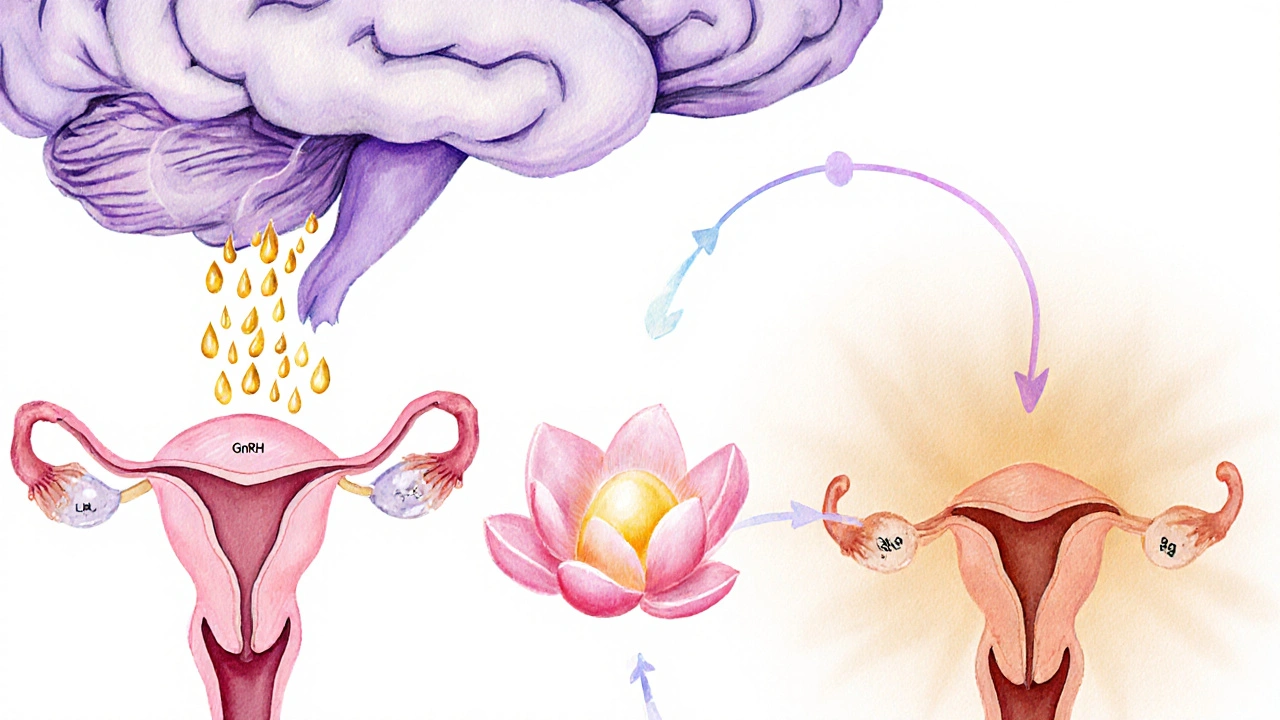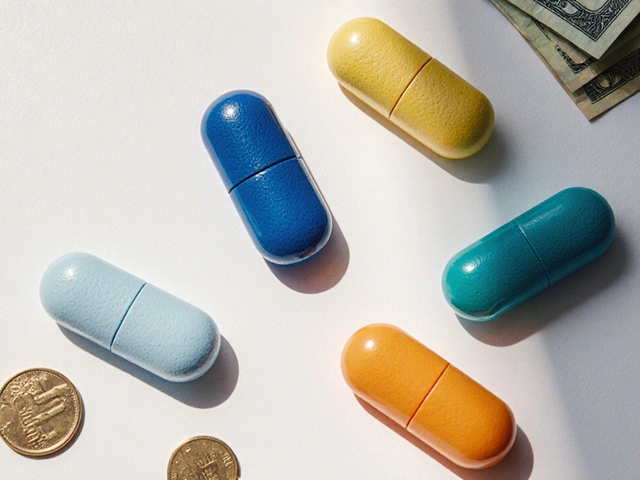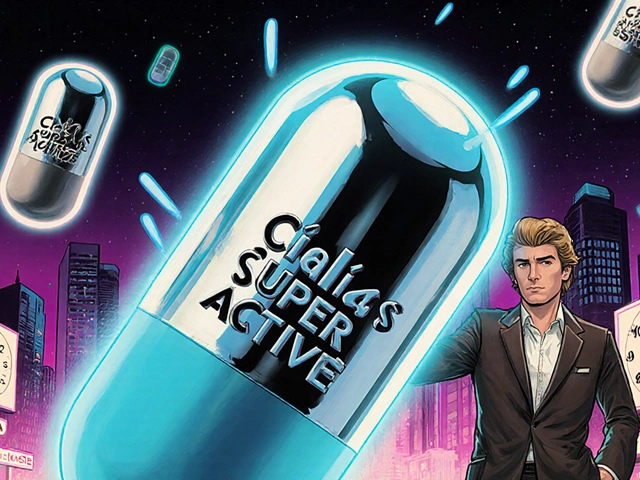Estrogen & Progesterone Cycle Simulator
Estrogen
Builds uterine lining and triggers ovulation
Progesterone
Stabilizes lining and triggers menstruation if no pregnancy
Follicular Phase
Estrogen rises, uterine lining thickens
Estrogen: High
Progesterone: Low
Visual representation of hormone levels over a 28-day cycle
Key Takeaways
- Estrogen builds the uterine lining and primes the body for ovulation.
- Progesterone stabilises the lining after ovulation and triggers its shedding if pregnancy does not occur.
- The hypothalamus‑pituitary‑ovarian (HPO) axis creates a feedback loop that times each hormone’s rise and fall.
- Stress, weight changes, and certain medical conditions can disrupt this balance, leading to irregular cycles.
- Simple lifestyle tweaks-adequate sleep, balanced nutrition, and stress management-support healthy hormone rhythms.
Understanding how estrogen and progesterone work together is essential for reproductive health.
Hormonal Basics: Estrogen and Progesterone
Estrogen is the primary female sex hormone that promotes the growth of the uterine lining, regulates the menstrual cycle, and influences bone density and cardiovascular health. Its levels start low after menstruation, rise steadily during the follicular phase, and peak just before ovulation.
Progesterone is a hormone produced mainly by the corpus luteum after ovulation that prepares the uterus for a potential pregnancy and moderates the effects of estrogen. It remains low during the first half of the cycle, then surges after the egg is released, keeping the uterine lining stable.
How They Drive Ovulation
Ovulation is the release of a mature egg from the ovary. The process begins when rising estrogen signals the hypothalamus to secrete gonadotropin‑releasing hormone (GnRH). GnRH travels to the pituitary gland and triggers a surge of luteinising hormone (LH) and a smaller rise in follicle‑stimulating hormone (FSH).
The LH spike forces the dominant follicle to rupture, releasing the egg - this is ovulation. Immediately after, the empty follicle transforms into the corpus luteum, which begins producing progesterone.
Role in Menstruation
If fertilisation does not occur, the corpus luteum degenerates after about 10‑14 days, causing progesterone levels to fall sharply. The sudden drop removes the hormonal support that kept the uterine lining thick, leading to its breakdown and shedding - the menstrual flow.
During the early part of the cycle (menstrual phase), estrogen is low, allowing the lining to be shed. As the next follicular phase begins, estrogen rises again, rebuilding the lining for the upcoming cycle.

Feedback Loops: The HPO Axis
The hypothalamus‑pituitary‑ovarian (HPO) axis works like a thermostat. When estrogen climbs, it first provides a positive feedback to the hypothalamus and pituitary, culminating in the LH surge. After ovulation, high progesterone (and the second estrogen peak) switch to negative feedback, telling the hypothalamus and pituitary to dial down GnRH, LH, and FSH production.
This alternating feedback ensures that each phase of the cycle lasts the appropriate length - roughly 14 days for the follicular phase and 14 days for the luteal phase in a typical 28‑day cycle.
Factors That Disrupt Hormone Balance
Several internal and external factors can tilt the delicate estrogen‑progesterone balance:
- Stress: Cortisol can blunt GnRH secretion, delaying or suppressing ovulation.
- Weight fluctuations: Low body fat reduces estrogen production; excess fat can increase estrogen conversion and disrupt the LH surge.
- Polycystic ovary syndrome (PCOS): Elevated androgen levels interfere with normal follicle development, often leading to persistently high estrogen and low progesterone.
- Perimenopause: Ovarian reserve declines, causing erratic estrogen spikes and insufficient progesterone, resulting in irregular bleeding.
- Medications: Hormonal contraceptives, certain antidepressants, and anti‑epileptic drugs can alter the natural rhythm.
Recognising these influences helps you understand why a previously regular cycle might become irregular.
Practical Tips to Support Healthy Hormone Rhythm
- Balanced diet: Include phyto‑estrogenic foods like flaxseed and soy in moderation, along with omega‑3 fatty acids that support progesterone synthesis.
- Regular movement: Moderate aerobic exercise improves insulin sensitivity, which in turn stabilises estrogen levels.
- Stress reduction: Practices such as mindfulness, yoga, or deep‑breathing lower cortisol, allowing the HPO axis to function smoothly.
- Sleep hygiene: Aim for 7‑9 hours; sleep deprivation can disrupt GnRH pulses.
- Maintain a healthy weight: Both under‑ and overweight conditions affect hormone production.
If you suspect a hormonal imbalance, a blood panel measuring estradiol, progesterone, LH, FSH, and thyroid hormones can pinpoint the issue. Always discuss results with a qualified clinician.
Estrogen vs. Progesterone - Quick Comparison
| Aspect | Estrogen | Progesterone |
|---|---|---|
| Primary source | Developing ovarian follicles | Corpus luteum (and later placenta) |
| Cycle phase dominance | Follicular (first 14 days) | Luteal (second 14 days) |
| Main action on uterus | Stimulates endometrial proliferation | Stabilises and maintains the thickened lining |
| Effect on ovulation | Triggers LH surge via positive feedback | Provides negative feedback after ovulation |
| Other systemic roles | Bone health, lipid metabolism, mood regulation | Thermoregulation, sleep quality, anti‑inflammatory effects |
Frequently Asked Questions
Why does my period become irregular during high stress?
Stress raises cortisol, which can suppress GnRH release from the hypothalamus. Lower GnRH means less LH and FSH, delaying or skipping the ovulatory surge and causing a missed or delayed period.
Can low body fat affect estrogen levels?
Yes. Fat tissue produces aromatase, an enzyme that converts androgens into estrogen. Very low body fat reduces aromatase activity, leading to lower circulating estrogen, which can result in light or absent periods.
What is the purpose of the mid‑cycle estrogen peak?
The mid‑cycle estrogen surge provides the positive feedback needed for the hypothalamus and pituitary to unleash the LH surge, which triggers the final maturation and release of the egg.
How long does the luteal phase usually last?
In a typical 28‑day cycle, the luteal phase lasts about 12‑14 days, from ovulation to the onset of menstruation. Consistent luteal lengths suggest a healthy progesterone response.
Are there natural ways to boost progesterone?
Maintaining steady blood sugar, ensuring adequate vitamin B6 and magnesium intake, and reducing excessive caffeine or alcohol can help the corpus luteum produce sufficient progesterone. Some herbs like chasteberry (Vitex) are also used, but you should consult a healthcare professional before supplementing.






Catherine Mihaljevic
October 5, 2025 AT 01:20Just another hormone plot they don’t want you to see
Callum Smyth
October 7, 2025 AT 15:16Hey, it’s cool you’re thinking critically 😊. Hormones are a natural part of the cycle and understanding them can empower you.
Kyle Salisbury
October 10, 2025 AT 05:13From a cultural standpoint, many societies celebrate the menstrual cycle as a rite of passage. It’s interesting how estrogen and progesterone are woven into myths and rituals. The biological details add depth to those stories.
Emmons Kimery
October 12, 2025 AT 19:10Thanks for sharing that perspective! 🌟 It’s cool to see the science behind traditions. Estrogen’s rise and progesterone’s fall really do echo the cycles we honor.
Mimi Saki
October 15, 2025 AT 09:06Hormone swings can feel like a roller‑coaster, but they’re essential for fertility. Learning how they work makes the ride less intimidating.
Subramaniam Sankaranarayanan
October 17, 2025 AT 23:03Estrogen rises during the follicular phase and prepares the endometrium for possible implantation. It also stimulates the growth of the ovarian follicle. When estrogen reaches a threshold, it triggers the hypothalamic release of GnRH. This surge leads to a luteinizing hormone (LH) spike that causes ovulation. After ovulation, the ruptured follicle transforms into the corpus luteum. The corpus luteum secretes progesterone. Progesterone stabilizes the endometrial lining, making it receptive. If fertilization does not occur, progesterone levels fall. The decline of progesterone initiates the breakdown of the lining. This breakdown results in menstrual bleeding. Stress can blunt the estrogen surge and delay ovulation. Weight fluctuations alter the balance of leptin, influencing hormone production. Polycystic ovary syndrome often presents with persistently high estrogen and low progesterone. Thyroid disorders can also disrupt the delicate feedback loop. Lifestyle factors such as diet and exercise modulate insulin, which in turn affects hormone levels. Understanding these interactions helps clinicians personalize treatment.
shawn micheal
October 20, 2025 AT 13:00Whoa, that’s a massive info dump! 🤯 It’s exactly why we need to respect the body’s timing and not try to shortcut the process.
John Hoffmann
October 23, 2025 AT 02:56While the enthusiasm is appreciated, the paragraph could benefit from a few commas for readability, and perhaps a semicolon after “follicle.” Also, “its” should be capitalized when starting a new sentence.
Shane matthews
October 25, 2025 AT 16:53I find it helpful when explanations stay concise and stick to the core mechanisms.
Rushikesh Mhetre
October 28, 2025 AT 05:50Exactly!! 🎉 Conciseness is key, but don’t forget the little details that make the picture complete!!!
Halid A.
October 30, 2025 AT 19:46Could we explore how feedback loops between the hypothalamus, pituitary, and ovaries maintain hormonal balance? A more formal outline would be beneficial for academic readers.
Vaibhav Sai
November 2, 2025 AT 09:43Indeed-this intricate dance is nothing short of a symphonic masterpiece! 🎶 The hypothalamus cues the pituitary, which in turn orchestrates ovarian secretions; each note must be perfectly timed.
Crystal Heim
November 4, 2025 AT 23:40Many people overlook the impact of lifestyle on hormone levels.
Sruthi V Nair
November 7, 2025 AT 13:36True-our daily choices echo in the body’s chemistry, reminding us that health is a philosophy as much as a science.
lee charlie
November 10, 2025 AT 03:33Understanding the cycle can reduce anxiety for many who feel out of sync.
Greg DiMedio
November 12, 2025 AT 17:30Oh yeah, because reading a guide totally solves every hormonal mystery… 🙄
Badal Patel
November 15, 2025 AT 07:26Esteemed readers, behold the grand tapestry of endocrine orchestration! With each rise and fall of estrogen and progesterone, the body performs a drama most profound, worthy of scholarly reverence.
KIRAN nadarla
November 17, 2025 AT 21:23While the prose is flamboyant, the data remain unchanged: hormonal dysregulation leads to clinical consequences.
Kara Guilbert
November 20, 2025 AT 11:20People need to stop ignorning the moral implications of meddling with natural cycles. It's a sin to manipulatе.